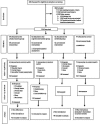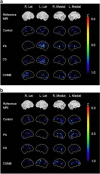A combination of physical activity and computerized brain training improves verbal memory and increases cerebral glucose metabolism in the elderly
- PMID: 25463973
- PMCID: PMC4270308
- DOI: 10.1038/tp.2014.122
A combination of physical activity and computerized brain training improves verbal memory and increases cerebral glucose metabolism in the elderly
Abstract
Physical exercise interventions and cognitive training programs have individually been reported to improve cognition in the healthy elderly population; however, the clinical significance of using a combined approach is currently lacking. This study evaluated whether physical activity (PA), computerized cognitive training and/or a combination of both could improve cognition. In this nonrandomized study, 224 healthy community-dwelling older adults (60-85 years) were assigned to 16 weeks home-based PA (n=64), computerized cognitive stimulation (n=62), a combination of both (combined, n=51) or a control group (n=47). Cognition was assessed using the Rey Auditory Verbal Learning Test, Controlled Oral Word Association Test and the CogState computerized battery at baseline, 8 and 16 weeks post intervention. Physical fitness assessments were performed at all time points. A subset (total n=45) of participants underwent [(18)F] fluorodeoxyglucose positron emission tomography scans at 16 weeks (post-intervention). One hundred and ninety-one participants completed the study and the data of 172 participants were included in the final analysis. Compared with the control group, the combined group showed improved verbal episodic memory and significantly higher brain glucose metabolism in the left sensorimotor cortex after controlling for age, sex, premorbid IQ, apolipoprotein E (APOE) status and history of head injury. The higher cerebral glucose metabolism in this brain region was positively associated with improved verbal memory seen in the combined group only. Our study provides evidence that a specific combination of physical and mental exercises for 16 weeks can improve cognition and increase cerebral glucose metabolism in cognitively intact healthy older adults.
Figures




Similar articles
-
Post-carotid endarterectomy changes in cerebral glucose metabolism on (18)F-fluorodeoxyglucose positron emission tomography associated with postoperative improvement or impairment in cognitive function.J Neurosurg. 2015 Dec;123(6):1546-54. doi: 10.3171/2014.12.JNS142339. Epub 2015 Jul 31. J Neurosurg. 2015. PMID: 26230467
-
Metabolic correlates of Rey auditory verbal learning test in elderly subjects with memory complaints.J Alzheimers Dis. 2014;39(1):103-13. doi: 10.3233/JAD-121684. J Alzheimers Dis. 2014. PMID: 24150105 Clinical Trial.
-
Effects of a 14-day healthy longevity lifestyle program on cognition and brain function.Am J Geriatr Psychiatry. 2006 Jun;14(6):538-45. doi: 10.1097/01.JGP.0000219279.72210.ca. Am J Geriatr Psychiatry. 2006. PMID: 16731723 Clinical Trial.
-
Beta-amyloid associated differential effects of APOE ε4 on brain metabolism in cognitively normal elderly.Am J Geriatr Psychiatry. 2014 Oct;22(10):961-70. doi: 10.1016/j.jagp.2013.12.173. Epub 2014 Jan 4. Am J Geriatr Psychiatry. 2014. PMID: 24495404
-
Overnight olfactory enrichment using an odorant diffuser improves memory and modifies the uncinate fasciculus in older adults.Front Neurosci. 2023 Jul 24;17:1200448. doi: 10.3389/fnins.2023.1200448. eCollection 2023. Front Neurosci. 2023. PMID: 37554295 Free PMC article. Review.
Cited by
-
Promoting neuroplasticity and neuropsychological functioning in frailty through an app-based sensorimotor training: study protocol for a randomized trial.BMC Geriatr. 2021 Jun 3;21(1):343. doi: 10.1186/s12877-021-02293-9. BMC Geriatr. 2021. PMID: 34082710 Free PMC article.
-
Effect of Combined Physical and Cognitive Interventions on Executive Functions in OLDER Adults: A Meta-Analysis of Outcomes.Int J Environ Res Public Health. 2020 Aug 25;17(17):6166. doi: 10.3390/ijerph17176166. Int J Environ Res Public Health. 2020. PMID: 32854323 Free PMC article. Review.
-
Effects of Rhythm Step Training on Physical and Cognitive Functions in Adolescents: A Prospective Randomized Controlled Trial.Healthcare (Basel). 2022 Apr 12;10(4):712. doi: 10.3390/healthcare10040712. Healthcare (Basel). 2022. PMID: 35455889 Free PMC article.
-
Brain Health Indicators Following Acute Neuro-Exergaming: Biomarker and Cognition in Mild Cognitive Impairment (MCI) after Pedal-n-Play (iPACES).Brain Sci. 2023 May 23;13(6):844. doi: 10.3390/brainsci13060844. Brain Sci. 2023. PMID: 37371324 Free PMC article.
-
Protective Factors Modulate the Risk of Beta Amyloid in Alzheimer's Disease.Behav Neurol. 2020 Oct 29;2020:7029642. doi: 10.1155/2020/7029642. eCollection 2020. Behav Neurol. 2020. PMID: 33178360 Free PMC article.
References
-
- World Health Organization . Dementia: a Public Health Priority. World Health Organization: Geneva, Switzerland; 2012.
-
- de Bruijn RF, Schrijvers EM, de Groot KA, Witteman JC, Hofman A, Franco OH, et al. The association between physical activity and dementia in an elderly population: the Rotterdam Study. Eur J Epidemiol. 2013;28:277–283. - PubMed
-
- Barberger-Gateau P, Raffaitin C, Letenneur L, Berr C, Tzourio C, Dartigues J-F, et al. Dietary patterns and risk of dementia The Three-City cohort study. Neurology. 2007;69:1921–1930. - PubMed
-
- Scherder EJ, Bogen T, Eggermont LH, Hamers JP, Swaab DF. The more physical inactivity, the more agitation in dementia. Int Psychogeriatr. 2010;22:1203–1208. - PubMed
-
- Access Economics Keeping dementia front of mind: incidence and prevalence 2009-2050. Alzheimer's Australia 2009. Available at http://www.alzheimers.org.au/upload/Front_of_Mind_Full_Rep ort1 pdf .
Publication types
MeSH terms
Substances
LinkOut - more resources
Full Text Sources
Other Literature Sources
Medical
Miscellaneous

